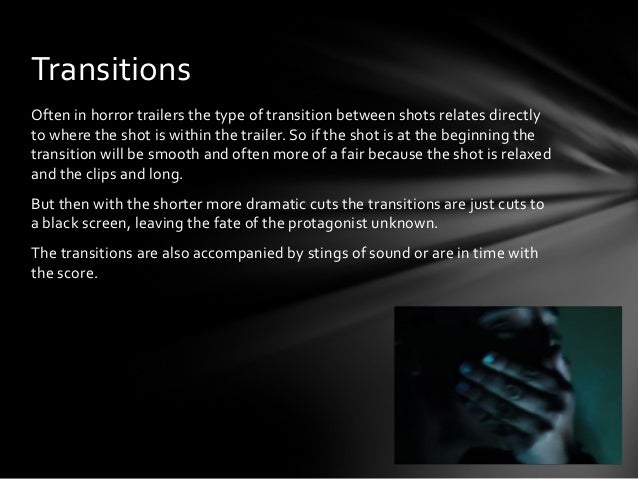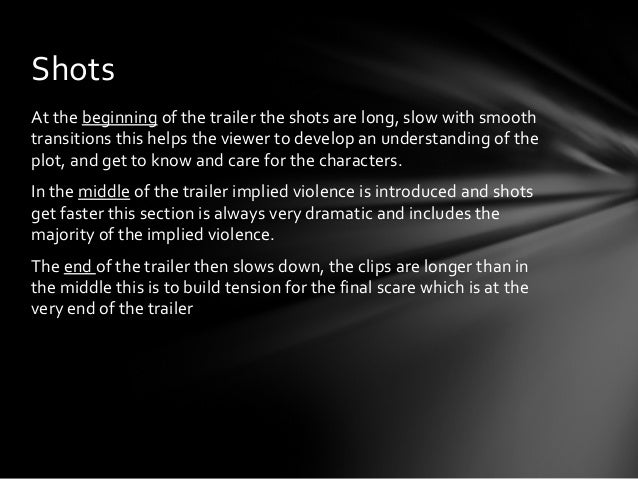The Horrors Of Editing
Instead of the usual 60 second tutorial this Wednesday, I decided to do something I haven't done in a while. This breakdown video compares the raw footage fr. The horrors of editing. 6/28/2017 12 Comments It's been a while I posted an update and I owe this to you guys! At the moment I'm revising the story and scripts.
Often the job of a film editor is overlooked. But when it comes down to it, the core pillars of filmmaking can be argued to consist of the screenplay (pre-production), the direction (production) and the editing (post-production). A bad edit can mean disaster for a film, whereas on the flip side, a good edit can elevate a film from good to great and beyond.
Editing is an invisible art, and takes an incredible amount of skill. People often do not realise how much work goes in to editing, or are even aware that they are watching the work of an editor when they watch a film, as a good editor is able to make their cuts seamless and fluid.
Horror Edition 7 Second Riddles
This list looks at some films which can be argued to amongst the best edited films of the 21st century. Each imminently different in their approaches, but each incredibly effective and skilful.
10. The Social Network (Edited by Angus Wall and Kirk Baxter)
In a film that is mostly driven by its dialogue, a strong edit was needed to make sure that the film came together in the way that it was envisioned in Aaron Sorkin’s masterful script. Luckily editors Angus Wall and Kirk Baxter were very happy with the footage. Baxter reveals that The Social Network, “was very well scripted and directed, so not a lot of storytelling issues had to be resolved in the edit.
In fact, there were a number of scenes that were great fun to put together. For example, there’s an early scene about some of the legal depositions. It takes place in two different boardrooms at different times and locations, but the scene is intercut as if it is one continuous conversation. David [Fincher, the director] gave us lots of coverage, so it was a real joy to solve the puzzle, matching eyelines and so on.”
- Hello, I am Ling Hua. I am a rotoscoping, wire removal and compositing artist,specialise in After effects,mocha,silhouette and Nuke. I work on with a team which strive to provide the ultimate combination of quality and affordability in visual effects, editing, color correction/finishing, animation and stereo 3D conversion to some of the most demanding projects in china and around the world.We.
- Camera All types of wide shots are often used to show the figures of intruders - the shot hides their identity but still lets us know they're present. In this clip from JAWS (1975) we see the girl in water from the sharks point of view - the victim is unaware of whats lurking.
- Horror is a very specific genre that calls for some unique lighting techniques. These five cinematography tips will make just about any horror film more stylized and effective. Horror films are all about tone, texture, and mood. Unlike many other genres that rely more heavily on other elements (dialogue, plot points, etc.), great horror films.
Baxter and Wall felt very strongly about making sure that the focus was concentrated on the drama of the characters and their emotions, rather than the drama of the actual social network and the computer based side. They did however face the mammoth task of making sure that the film propelled along at a good pace.
Director David Fincher would often do up to 60 takes on certain shots, so Wall and Baxter had to shift through a lot of footage to find the perfect takes to use. In the end the edit came together so successfully that The Social Network won an Academy Award for Best Editing at the 83rd Academy Awards.
9. Baby Driver (Edited by Paul Machliss and Jon Amos)
Music drives every single scene in Baby Driver, and everything that lead character Baby does is done to a soundtrack. Editor Paul Machliss explains, “His whole life becomes regimented to the music he is listening to—different music for different moods or occasions.
Somehow everything falls magically into sync with whatever he is listening to. When he’s driving, swerving to avoid a car, making a turn, it all seems to happen on the beat.” This meant that the edit had to be perfectly constructed in order to sync the action, choreography and music. Machliss also had to add sound effects within the music, yet never lose the beat of the edit.
This emphasis on the music meant that Machliss and Amos took a slightly unusual approach to the editing, in that a lot of the editing was done on set using a portable set up. But this method was highly helpful to Machliss, as it meant that he went into post production with the knowledge that the sequences worked well.
Regardless of that, Machliss described Baby Driver as the most difficult edit that he has ever worked on. But Machliss’ hard work definitely paid off, and the edit brings Baby Driver together in an amazingly well choreographed and skilful film which has to be watched – to both enjoy the film, but also to appreciate the invisible art of the edit.
8. Black Hawk Down (Edited by Pietro Scalia)
Black Hawk Down is a film where the effective edit elevates the film from brilliant to outstanding. It also manages to encapsulate and portray the many elements of war – from moments of camaraderie between the soldiers to the heart-breaking losses suffered, from the overwhelming noise and chaos to the eerily still moments of uncertainty.
Matching the gritty realism of real world violence with more emotionally driven character psychology was one of the challenges that editor Pietro Scalia faced, but in using a variety of techniques, he managed to successfully cut together an edit which makes Black Hawk Down a highly impactful film.
The cutting and pacing of the film is very important, both for the edit and the narrative. Black Hawk Down is another film which uses a higher number of cuts compared to other films. This helps present the film as high octane and fast-paced. In particular the various different cuts of bullets flying, the frenzied cross cutting and the relentless pace makes the film not only feel like a war film but also an action film.
All of Scalia’s editing expertise and skill brings Black Hawk Down together to present a film which can be argued as possibly the best edited of all of Ridley Scott’s films. Black Hawk Down went on to win an Academy Award for Best Editing at the 74th Academy Awards.

7. Lord of the Rings: The Return of the King (Edited by Jamie Selkirk)
Lord of the Rings: Return of the King is one of the most commercially and critically successful films of all time. It is also considered the most successful fantasy of all time, and is the only fantasy film to win an Academy Award for Best Picture. In amongst its many awards, it also won an Academy Award for Best Editing. The monumental scale of production translated into a monumental task for post-production, and presented its own set of unique challenges for editor Jamie Selkirk.
By the end of filming, Selkirk had around 2 million feet of film to sift through for the edit. There were also several different elements to consider in terms of the footage – the use of miniatures, green screen footage and blue screen footage. The film also had to follow on concisely from the second film and match its look and tone. And the main focus for Selkirk was that he always saw the film as emotionally driven rather than effects driven.
As well as technical challenges, there were the narrative challenges of showing several concurring storylines and wrapping up the story in an effective manner. Using a clever mix of cross-cutting, fast cuts, and a myriad of other techniques, Selkirk created an edit that was highly effective in showing the massive scope of the battle scenes yet also effectively showed the character driven emotional scenes.
The overall edit was able to contribute to the film’s fantastical qualities, and was another reason that it was so well received and remains one of the most popular films of all time.
6. The Bourne Ultimatum (Edited by Christopher Rouse)
There are 37 cuts in the first minute of The Bourne Ultimatum alone. That accurately sums up the editing style of the film. Fast, frenetic and nonstop – the editing style of The Bourne Ultimatum took action films to another level.
Editor Christopher Rouse makes it his mission to cut action sequences uniquely for every different director he works with. For director Paul Greengrass, this meant a more aggressive and powerful edit. Rouse wanted moments in the film to occur in the blink of an eye and then disappear. In that way, the audience is always glued to the screen and watching to try and take everything in.
The film itself was shot with three cameras, which meant that Rouse had plenty of footage to choose from. This also allowed Rouse to use a variety of shots from each camera cut together to give the audience the feeling of experiencing everything around you. Rouse’s main thought behind the edit was for it to reflect the mindset of main character Jason Bourne. Rouse said “Jason is uneasy; he’s questioning; he’s in search of his identity. He is sort of a shark moving through the water; he is never particularly comfortable in his environment.
Horror Edition
In support of that, a lot of the material tends to lend itself to jump cutting.” The result of this was an edit that consisted of around 4000 cuts. The Bourne Ultimatum was recognised for its technically brilliant editing when it won the Academy Award for Best Editing at the 80th Academy Awards.
The Horrors Of Editing Free

In a remote Brazilian slum, men prepare a chicken dinner. A single chicken realizes he is in danger, then escapes. Divorced from sight and sound, the idea is hardly compelling. However, through deliberate editing, by splicing shots into a visual frenzy and supporting every cut with a rich soundscape, a filmmaker can craft this concept into a world that engages the viewer on the most visceral level.
My favorite opening sequence of all time is from Fernando Meirelles’ film “City of God” (2003). There are more than 50 visual cuts in the first 30 seconds. But before the audience sees a single frame, they are put on guard by sound.
The film starts with an extremely quick L-cut from a black screen. Before the viewer sees the knife, we hear the sound of metal scraping against rock. The sound is followed by a close-up of a hand pulling a blade over a whetstone. The screen cuts to black immediately after the knife exits frame. The sound finishes. From black to image to black again, the entire sequence takes less than one second. The editor repeats this sequence five times. Each time either the direction of the knife or the composition changes. The scraping creates an unsettling rhythm. The rhythm of the knife contrasts with the hectic beat of a Brazilian instrumental that fades up after the third scrape. A close up of a man playing guitar is on the screen for a fraction of a second. Title Sequence. That’s just the first 8 seconds. I’m all in. My attention is grabbed. The knife presents danger; the quick cuts propel the scene forward.
Watch the video. I could describe every sound and shot, but it is better to experience them. However, I will highlight some of the techniques at work.
The Horrors Of Editing Softwares
The frequency of cuts increases as the first minute progresses. The editor also removes the cuts to black. This makes the sequence feel like it is building energy. Almost all of the shots in the first minute are close-ups. There are no establishing shots. This provides a lot of detail, but the quick cutting between tight shots also can make the viewer feel claustrophobic. The hand-held camera work provides energy and lends itself to the chaotic tone.
There is a great application of the Kuleshov effect as the editor cuts back and forth between the chicken’s face and the meal. The chicken wasn’t acting. A chicken’s expression doesn’t change. Sorry. No chicken has yet won an Oscar. However, through editing and the use of close-up, the audience identifies with the chicken and assumes that he is reacting to the horror he sees before him.
While researching this scene, I learned that there is a technique at work here called “elliptical editing.” This technique describes how the shots are sequenced in order to compress time. For instance, something like sharpening a knife and preparing a meal is communicated in several seconds rather several hours. I had not heard this term before, but it’s a common technique. I’ll add it to my vocabulary list.

The Horrors Of Editing Freeware
The chicken gets escapes. The pursuers follow. The story continues. I highly recommend watching this film. One can observe great audio and visual editing throughout. The editors also use music effectivelyto create atmosphere. City of God won numerous awards, including a BAFTA for Best Editing. It was also nominated for four Academy Awards.
